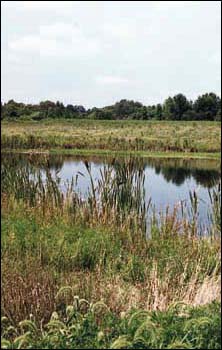Three Years After - Failure or Successby Susan Wind |
 You may recall an article that appeared in the September/October 1994 issue of Land & Water titled 'The U.S. 127 Wetlands Mitigation' by Dennis Feeback. The article discussed mitigation details such as topsoil replacement, berm construction and revegetation efforts for the project. Two methods of revegetation were utilized. First a nearby area was chosen from which native soil and seedbank material would be scalped and utilized. Secondly, the entire area would be seeded with a 'wet-mix'. This seed mixture consisted of 60% perennial rye and 40% seeds from five species chosen from a list of 32 wetland plants. As the first article reported, the project went well. Hydrology was established on the mitigation site and today the vegetation appears vigorous and lush. From U. S. 127 it appears that cattails have developed into a monoculture. The original author noticed this and wondered why. Since cattail had not been included in the 'wet-mix' seed, nor had it been present in the topsoil borrow area, how had the plant community - which was not what had been planned, nor planted - develop this way? Before this answer could be pursued, Mr. Feeback felt a survey should be done on the area to see if, in fact, nothing but cattail did exist. In late June, Mr. Feeback contacted me and asked if I would do a plant survey of the area. What I found was quite surprising to both myself and Mr. Feeback. In this mitigated site, I found an abundance of wetland and facultative wet species, and identified 16 different species of plants. At the drier edge of the intermittently saturated zone, I found timothy, Korean lespedeza, Serecia lespedeza and moneywart. Moving further into this zone I found the following: taper-tip rush, slender rush, white-root rush, blunt-broom sedge, fox sedge, hop sedge, black bull rush, wool grass, and spike rush. Within the shallow open water zone I found the following: cattail; creeping water - primrose, common water purslane, pickerelweed, arrowhead, and American wood sage. In another area of the wetland mitigation site, areas of fox sedge and wool grass comprised 100% of the vegetative cover. In other areas where cattail was thought to be the only plant, there were species such as arrowhead and pickerelweed growing among the stalks. These plants were small, indicating good reproduction. Swamp milkweed was also found to intersperse with the cattail. Several soil samples were pulled and the presence of hydric soils was evident throughout the saturated zone. Trees were examined, and although growth appears slow, most appear healthy. Certainly with the amount of diversity of wetland plants, even if these were not what was planted originally, this area should be considered very successful. Apparently, other species inhabited this site because of their suitability for their growth rather than that of the planted species. Natural invasion, given the right set of circumstances, may be the best end result of these types of projects, and initial seed mix is merely the mechanism to stop erosion and trap the invading seeds and give them a place to flourish. For more information, contact Susan Wind, staff biologist Department for Surface Mining Reclamation and Enforcement, US 127S, Hudson Hollow, Frankfort, Kentucky 40601, tel: (502) 564-2320, ext 696, fax: (502) 564-5848. |
©2000, 1999, 1998 Land and Water, Inc.